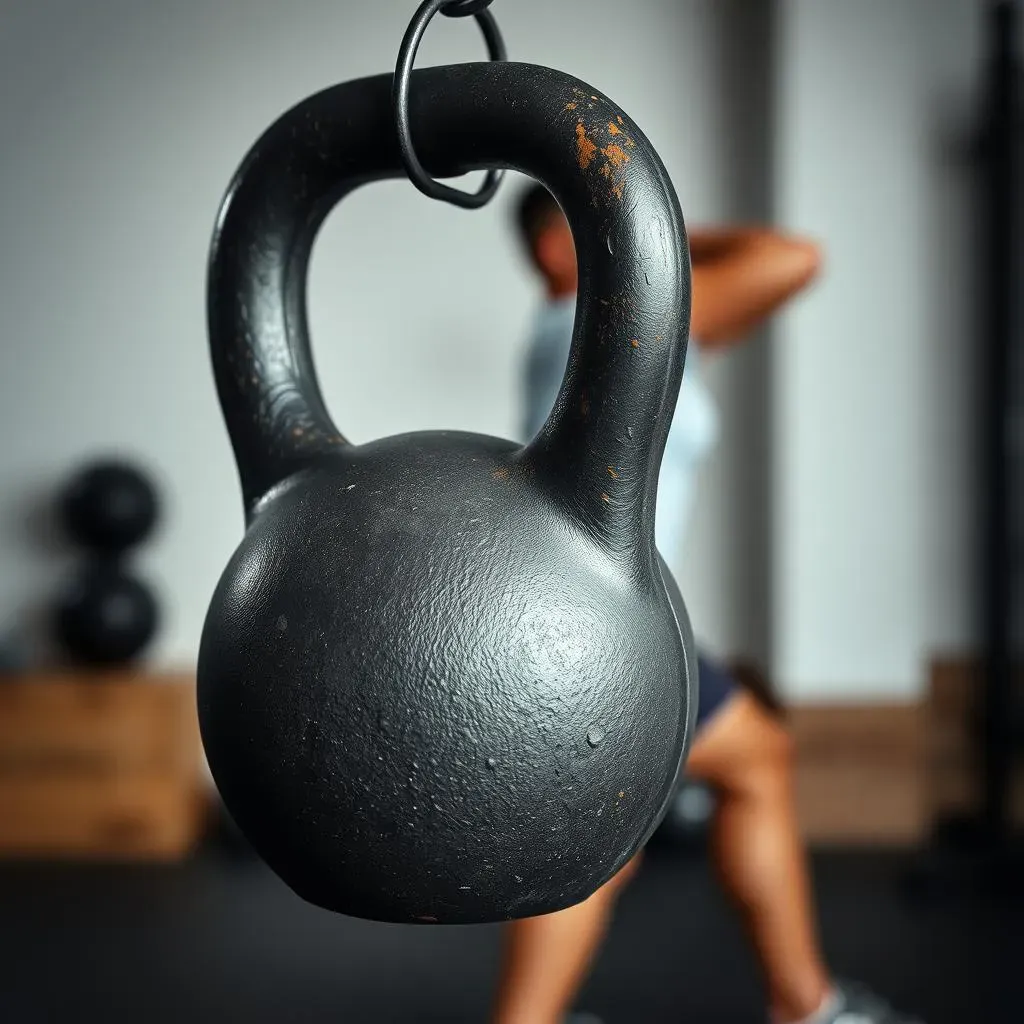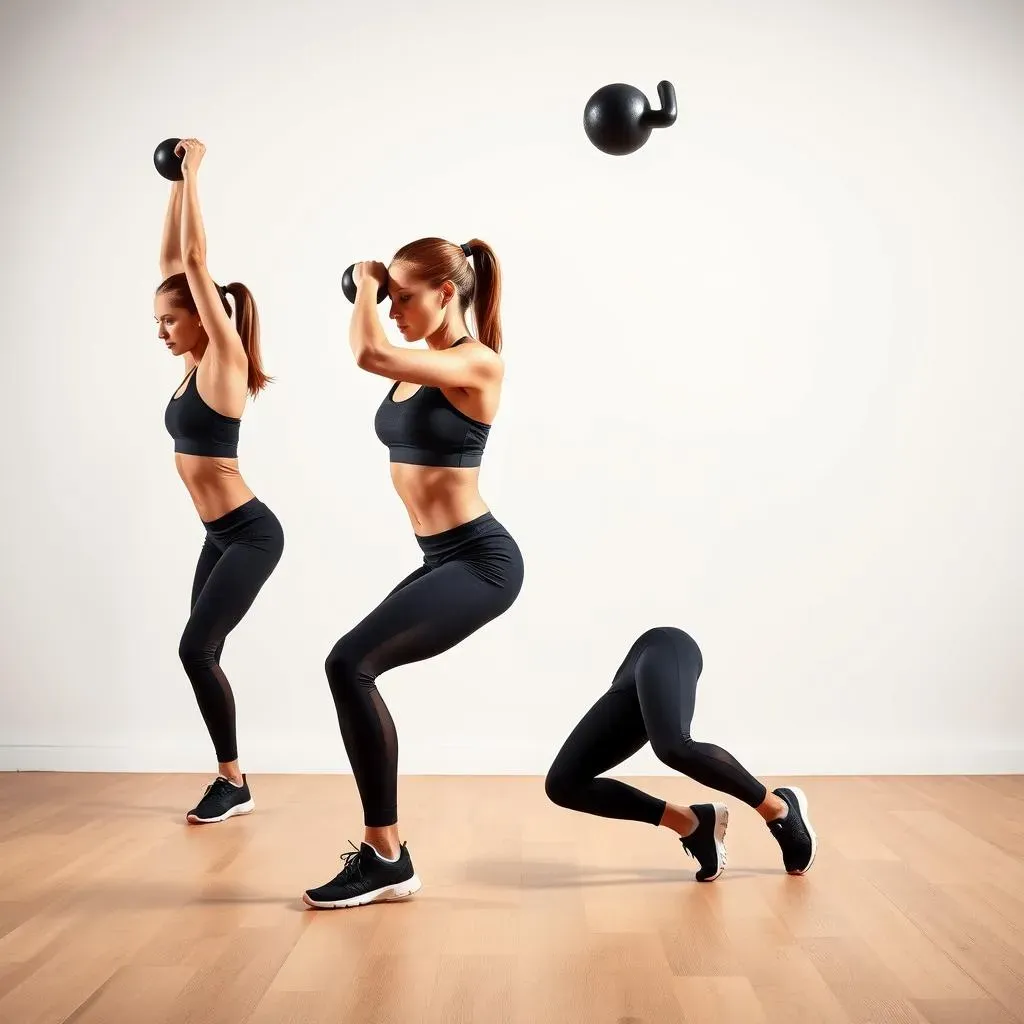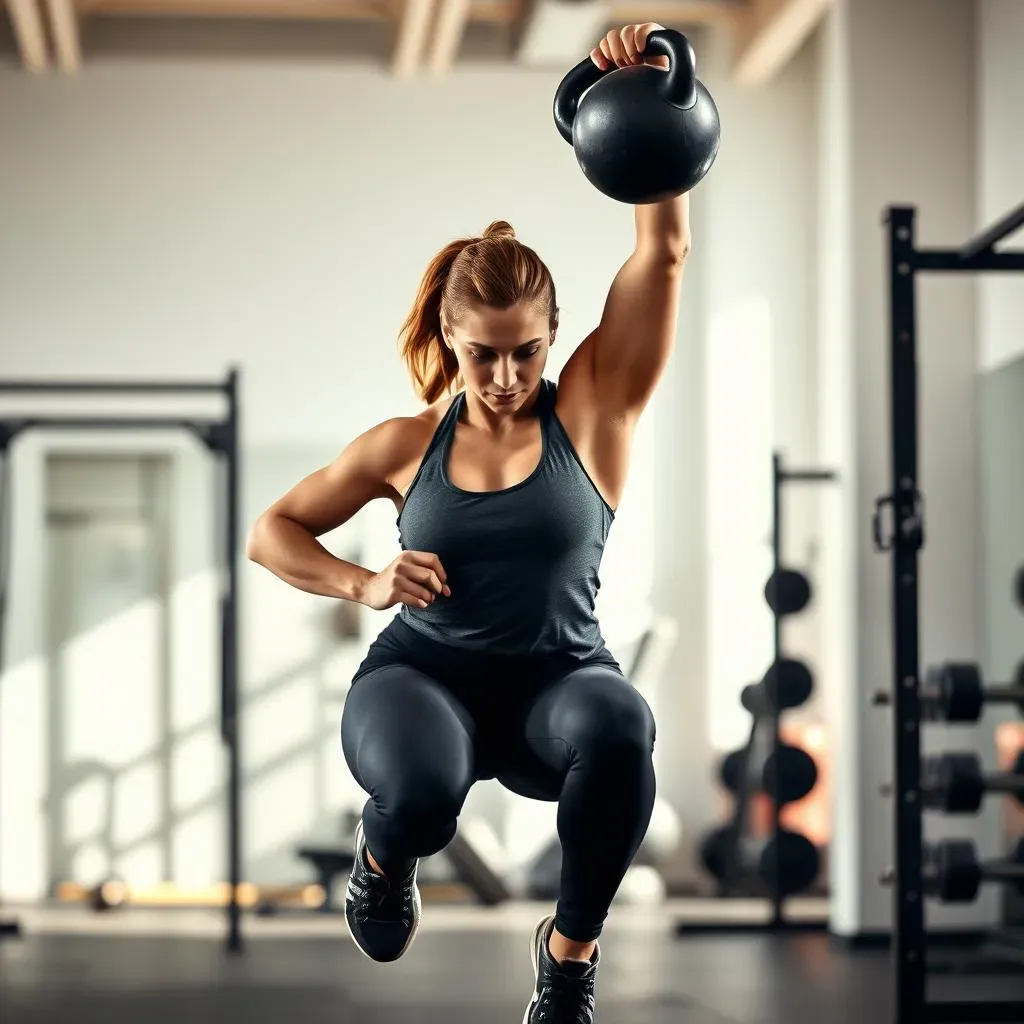Table of Contents
Ready to torch calories, build serious strength, and sculpt a rock-solid core? Then it's time to grab a kettlebell! A kettlebell leg and core workout is a killer way to target your lower body while simultaneously engaging your midsection. Unlike traditional weightlifting, the dynamic, off-center load of a kettlebell challenges your stability and forces your core to work overtime. This isn't just about building bigger muscles; it's about improving functional fitness, balance, and overall athleticism. This guide breaks down 12 of the most effective kettlebell exercises for your legs and core. We'll start with the fundamentals, like proper form for kettlebell swings and goblet squats, before moving on to more advanced movements like Bulgarian split squats and Turkish get-ups. Whether you're a seasoned athlete or just starting your fitness journey, we'll show you how to modify each exercise to fit your skill level. Get ready to unleash the power of the kettlebell and transform your leg and core strength!
Kettlebell Training Basics: Form and Function

Kettlebell Training Basics: Form and Function
Why Kettlebells? More Than Just a Weight
so you're curious about kettlebells. Awesome! These cannonball-shaped weights with handles aren't just a trendy fitness fad. They're a seriously effective tool for building strength, power, and endurance. But before you start swinging them around like a Viking warrior, let's nail down the basics. Kettlebell training is all about movement patterns, not just isolated muscle contractions. It's about learning to generate power from your hips and core, using your limbs as levers.
Think of it this way: a bicep curl isolates the bicep, but a kettlebell swing engages your entire posterior chain – glutes, hamstrings, back – while simultaneously challenging your core. That's why kettlebells are so effective for building functional strength, the kind you use in everyday life.
The Foundation: Mastering the Hinge
The hip hinge is the cornerstone of most kettlebell exercises. It's the movement pattern you use when you bend over to pick something up, but with a focus on maintaining a straight back and generating power from your hips. Many people mistakenly squat when they should be hinging, which puts unnecessary stress on the knees and lower back.
To practice the hinge, stand with your feet shoulder-width apart, knees slightly bent. Imagine there's a wall right in front of you. Push your hips back towards the wall, keeping your back straight and your core engaged. You should feel a stretch in your hamstrings. That's the hinge! Think of it like bowing, not squatting.
Grip It and Rip It (Safely!)
Your grip is crucial for kettlebell safety and effectiveness. A proper grip allows you to control the kettlebell and generate power without straining your wrists or forearms. There are several different grips you can use, depending on the exercise, but the most common is the "hook grip."
To perform the hook grip, wrap your fingers around the handle, placing the kettlebell diagonally across your palm. Your thumb should wrap around your fingers, creating a "hook." This grip allows you to maintain a secure hold on the kettlebell while allowing your forearms to remain relatively relaxed. A death grip will only tire you out faster and increase your risk of injury.
Common Kettlebell Grips:
- Hook Grip: Most common, versatile for swings and deadlifts.
- Overhand Grip: Used for rows and carries.
- Bottoms-Up Grip: Advanced, increases stability demands.
Kettlebell Swings and Goblet Squats: Foundation of Your Kettlebell Leg and Core Workout

Kettlebell Swings and Goblet Squats: Foundation of Your Kettlebell Leg and Core Workout
Kettlebell Swings: The King of Kettlebell Exercises
Alright, let's talk swings! The kettlebell swing is arguably the most iconic kettlebell exercise, and for good reason. It's a full-body movement that builds explosive power, strengthens your posterior chain, and torches calories like crazy. But it's also one of the most commonly butchered exercises, so let's break down the proper technique.
The swing is all about the hip hinge we talked about earlier. It's NOT a squat. Start with the kettlebell a few feet in front of you. Hinge down, grab the kettlebell with a hook grip, and hike it back between your legs like you're hiking a football. Then, explosively drive your hips forward, squeezing your glutes and sending the kettlebell up to chest height. Let the kettlebell swing back down between your legs, and repeat. The power comes from your hips, not your arms. Your arms are just along for the ride!
Goblet Squats: The Perfect Squat Primer
Now, let's move on to goblet squats. This exercise is fantastic for building leg strength and improving your squat form. Holding the kettlebell in front of your chest acts as a counterbalance, which helps you maintain a more upright posture and squat deeper. It's also a great way to load the legs without putting stress on your lower back.
To perform a goblet squat, hold the kettlebell close to your chest with both hands, like you're holding a goblet (hence the name). Stand with your feet shoulder-width apart, toes slightly pointed out. Keeping your back straight and your core engaged, squat down as deep as you can while maintaining good form. Your elbows should track inside your knees. Then, drive back up to the starting position, squeezing your glutes at the top. If you have trouble squatting deep, try elevating your heels slightly on a plate or a small book.
Exercise | Sets | Reps | Rest |
|---|---|---|---|
Kettlebell Swings | 3 | 15 | 60 seconds |
Goblet Squats | 3 | 10 | 60 seconds |
Advanced Kettlebell Leg Workout: Bulgarian Split Squats and SingleLeg Deadlifts

Advanced Kettlebell Leg Workout: Bulgarian Split Squats and SingleLeg Deadlifts
Bulgarian Split Squats: The King of Unilateral Leg Builders
Alright, let's crank up the intensity with Bulgarian split squats! This exercise is a beast for building single-leg strength, balance, and stability. Prepare to feel the burn in your quads, glutes, and hamstrings. Seriously, these things are tough, but incredibly effective.
To set up, you'll need a bench or a sturdy box. Stand facing away from the bench, and place one foot behind you on the bench. Your front foot should be far enough forward that your knee doesn't go past your toes when you squat down. Holding a kettlebell in front of your chest (goblet style), lower your back knee towards the ground, keeping your front knee tracking over your toes. Aim for your back knee to lightly touch the ground, then drive back up to the starting position. That's one rep! Make sure to keep your core engaged and your chest up throughout the movement.
Single-Leg Deadlifts: Hamstring Hero
Now, let's talk single-leg deadlifts. This exercise is a fantastic way to strengthen your hamstrings, glutes, and core while also improving your balance and coordination. It's a bit tricky to master, but once you get the hang of it, you'll be hooked.
Start by standing on one leg, holding a kettlebell in the opposite hand. Keeping your back straight and your core engaged, hinge at your hips, lowering the kettlebell towards the ground. As you lower the kettlebell, your non-supporting leg will naturally extend behind you for balance. Aim to lower the kettlebell as far as you can while maintaining good form, then drive back up to the starting position, squeezing your glutes at the top. It's important to keep your back straight and your core engaged throughout the movement to avoid rounding your lower back. If you're having trouble with balance, try focusing on a fixed point in front of you.
Exercise | Sets | Reps | Rest |
|---|---|---|---|
Bulgarian Split Squats | 3 | 8-12 (each leg) | 75 seconds |
Single-Leg Deadlifts | 3 | 8-12 (each leg) | 75 seconds |
Full Body Kettlebell Workout: Racked Squats, Turkish GetUps and Core Engagement

Full Body Kettlebell Workout: Racked Squats, Turkish GetUps and Core Engagement
Racked Squats: The Core Crusher
Alright, let's talk racked squats! This variation of the squat is a game-changer for core engagement. By holding the kettlebells in the racked position (close to your chest, elbows tucked in), you force your core to work overtime to stabilize your torso. It's like a plank and a squat had a baby – a very effective, muscle-building baby.
To perform a racked squat, clean two kettlebells up into the racked position. Stand with your feet shoulder-width apart, toes slightly pointed out. Keeping your back straight and your core engaged, squat down as deep as you can while maintaining good form. Your elbows should stay tucked in close to your body. Then, drive back up to the starting position, squeezing your glutes at the top. The racked position will challenge your balance and stability, so start with a lighter weight than you would for a back squat.
Muscle Group | Benefits |
|---|---|
Quads, Glutes, Core | Increased core stability, improved squat depth, enhanced balance. |
Turkish Get-Ups: The Ultimate Test of Coordination
Now, let's move on to the Turkish get-up. This exercise is a full-body masterpiece that challenges your strength, coordination, and mobility. It's a bit complex, but once you learn the steps, you'll feel like a total badass. The Turkish get-up is a slow, controlled movement that requires you to transition from lying on the ground to standing up, all while holding a kettlebell overhead. It's a fantastic way to improve your shoulder stability, core strength, and overall body awareness.
To perform a Turkish get-up, start by lying on your back with a kettlebell in one hand, arm extended towards the ceiling. Bend the knee on the same side as the kettlebell. Post the opposite arm out to the side at a 45-degree angle. Keeping your eyes on the kettlebell, sit up, propping yourself up on your posted arm. Then, bridge your hips up off the ground. Sweep your straight leg behind you, coming into a kneeling position. From the kneeling position, stand up, keeping the kettlebell overhead. Reverse the steps to return to the starting position. That's one rep! Start with a light weight and focus on mastering the movement before increasing the load.
Core Engagement: The Secret Sauce
Remember, core engagement is key to all of these exercises. Your core is your body's stabilizer, and it's essential for maintaining proper form and preventing injuries. Before each rep, take a deep breath and brace your core like you're about to get punched in the stomach. This will help you maintain a neutral spine and generate power from your center.
Think of your core as the engine of your body. It's what connects your upper and lower body and allows you to move efficiently and powerfully. By focusing on core engagement, you'll not only improve your performance in these exercises, but you'll also improve your overall functional fitness.
Kettlebell Leg and Core Workout: Variations and Progressions

Kettlebell Leg and Core Workout: Variations and Progressions
Ramping Up the Intensity: Advanced Kettlebell Exercises
So, you've mastered the basics – swings, goblet squats, Bulgarian split squats, and single-leg deadlifts. What's next? It's time to explore some more advanced kettlebell exercises that will challenge your strength, stability, and coordination even further. These variations will not only keep your workouts fresh and exciting but also help you break through plateaus and continue making progress toward your fitness goals.
Consider incorporating exercises like kettlebell snatches, windmills, and renegade rows into your kettlebell leg and core workout routine. These movements require a higher level of skill and control, so be sure to start with a lighter weight and focus on mastering the proper form before increasing the load. Remember, it's always better to prioritize quality over quantity.
Progressive Overload: The Key to Continued Growth
Once you've mastered the basic kettlebell exercises and their advanced variations, it's important to implement progressive overload to continue challenging your muscles and promoting growth. Progressive overload simply means gradually increasing the demands on your body over time. There are several ways to do this with kettlebell training:
- Increase the weight: This is the most obvious way to increase the intensity of your workouts.
- Increase the reps: Perform more repetitions of each exercise.
- Increase the sets: Perform more sets of each exercise.
- Decrease the rest: Shorten the rest periods between sets.
- Increase the difficulty: Progress to more challenging variations of each exercise.
Listen to Your Body: Prioritizing Recovery and Injury Prevention
As you increase the intensity and volume of your kettlebell leg and core workout, it's crucial to prioritize recovery and injury prevention. Kettlebell training can be tough on your joints, especially if you're not using proper form. Make sure to warm up properly before each workout and cool down afterward. Incorporate mobility and flexibility exercises into your routine to improve your range of motion and prevent muscle imbalances.
Most importantly, listen to your body. If you're feeling pain, stop the exercise and rest. Don't push through pain, as this can lead to serious injuries. Remember, consistency is key to long-term success. It's better to take a day off and recover than to push yourself too hard and risk getting injured.
Recovery Strategy | Benefits |
|---|---|
Foam Rolling | Reduces muscle soreness, improves flexibility |
Active Recovery (light cardio) | Increases blood flow, promotes healing |
Proper Nutrition | Fuels muscle repair and growth |
Conclusion: Kettlebell Leg and Core Workout - Your Path to Strength and Stability
Incorporating a kettlebell leg and core workout into your routine is a game-changer for building functional strength, improving balance, and sculpting a powerful physique. From mastering the fundamental swing to conquering the Turkish get-up, each exercise offers a unique challenge and a pathway to enhanced fitness. Remember to prioritize proper form, listen to your body, and gradually increase the intensity as you progress. With dedication and consistency, the kettlebell will become your go-to tool for unlocking your full potential and achieving your fitness goals.